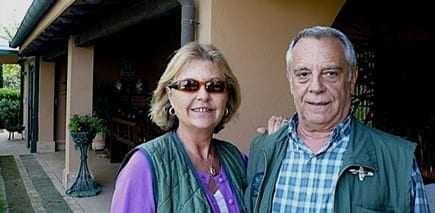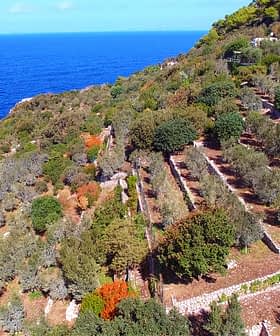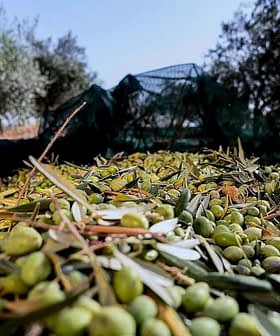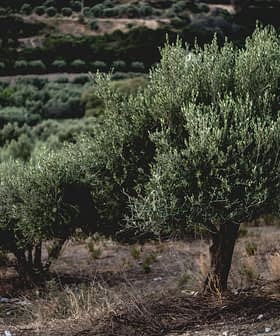
Two Sardinian shepherds owned the Nepi pastures before Fabrizia Cusani and Giampaolo Sodano bought the land in the 1990s. Now there are 7,000 olive trees on their rolling 20 hectares. Olivaia is the name of their olive farm, and Frantoio Tuscus is that of their mill, and brand of extra virgin olive oil. The groves are planted with two cultivars, the Caninese and the Bolzone, widely used in the area.
Their organically grown trees are remarkably healthy looking. Like a young couple talking about what they feed their children, Cusani and Sodano smile when they describe what they give their olive trees, the fish, the greens, the water – what they eat. Italian summers are dry. Olive foliage can look brittle, and the grass around trees is often a scorched yellow. Their groves are well watered, the leaves are soft and plump, the fruit is full looking, and any vegetation in the aisles, between the trees, is also green.
Nepi is a town north of Rome, out the Via Cassia, and the Olivaia is 42 km. from Michelangelo’s Campidoglio. The name Tuscus refers to the Etruscans who lived in the region, as does the Tuscia, the name commonly used for the province of Viterbo. The Tuscia is a D.O.P. region and Frantoio Tuscus oil has that certification, along with organic certification.
Fabrizia Cusani, now retired, was a professor of city planning at the University of Rome; and Sodano, an executive at RAI (Italian public television station), as well as a member of parliament. In the early 90s, when approaching retirement age, Sodano said that he and Cusani had the conversation, “ ‘What are we going to do when they expel us from the work world?’ We were terrorized. We didn’t have other work and you can’t vacation for 365 days a year. It’s not pleasurable.” He continues about how they chose to farm, “In a way it’s natural to think of agriculture because we’re the second generation not working the soil. Three generations ago everybody farmed. Until WWI everyone farmed, Italy was an agricultural enterprise. And in a way, you could say that our DNA for farming woke up.”
They originally thought of the farm not so much for profit making, but for its lifestyle value. Then, a frantoio (olive mill) came up for sale in the nearby town of Vetralla. They bought it in 1999 and this is where they extract, bottle, and package their 20 tons of olive oil, in addition to pressing another 100 tons. Frantoio Tuscus extracts oil from Leccino, Frantoio, Maurino, along with the Caninese and Bolzone cultivars. All of their oil is extracted within 24 hours of olive harvest.
At first things started slowly, Sodano was offered a job in cinema, meaning that he had to spend most of his time in Milan from 2000 to 2003, and that he was working the olive business “with my left hand.” Cusani stayed in Nepi and continued the business. Sodano says his wife has a keen sense for business, is always looking to make improvements, and is good at marketing. Their son, Gabriele Cusani Sodano, also works on the marketing.
The Frantoio Tuscus brand produces five types of extra virgin olive oil which is sold at a shop that is open year-round at the frantoio, and through large Italian supermarket chains. They sell 50,000 bottles through supermarkets such as Esselunga with 170 stores in the north of Italy, Despar in Rome, and others. Their export business is much smaller, though they sell in Japan, and in the US through the Whole Foods stores in the state of Washington. US sales are disappointing because the olive oil, after the markups of the importer/distributor, and Whole Foods, makes the bottle they sell wholesale at 5 euros into a $19 bottle in Washington – too expensive, they believe, to be sold in any quantity.
Cusani and Sodano approach olive oil with huge enthusiasm, the kind of enthusiasm that marks political or religious converts. They’ve taken courses (she’s a sommelier, he’s a master frantoiano), they read widely, they attend and participate at fairs and events. The day I visited, they were readying a guide of frantoios for publication by Sitcom (Society for Italian Communications), an Italian TV, publishing, and media company. Sitcom’s owner, who has an agricultural concern in Nepi, lured Sodano back to television and media in 2008. They met for lunch and the owner asked Sodano to lend a hand, which he was happy to do, saying “Working in television is like a drug, after a while you need to do it.” He commutes to Rome during the week and come Friday lunchtime, he returns to Nepi to work on the olive oil business.
During the olive harvest months of October, November, and December, he spends more time in Nepi and Vetralla. When they bought the frantoio, they put in a new Pieralisi system. He makes the more high-end oils, some of which he says are so labor intensive that they are not remunerative. The “frangitura” or crushing and kneading phase is where he focuses a lot of attention. By slowing the rotation of the Pieralisi hammers, he can get an olive oil which is less bitter and piquant. He’s thinking of introducing an Alfa-Laval crusher, whose action is more cutting than crushing to make a sweet oil. He says that a number of frantoios have both. Sodano is a vice president of AIFO, the Association of Italian Oil Millers. Because of his parliamentary and managerial experience, AIFO has grown in membership (another milling association decided to merge with AIFO) and is now recognized by the Agricultural Ministry. I asked him if what I’d read, that there were 6,000 frantoios in Italy, was true. It turns out there are 4,997 and about 1,500 of those are phantom frantoios, left over from when frantoios were subsidized for each liter they produced by the European Community, and were producing what he calls fraudulent “paper oil.” Before that packagers were subsidized by the bottle, and they produced, what he terms “bottles of air,” making huge fortunes in the process.
The association with Sitcom allows Cusani and Sodano to get the word out on olive oil. In addition to the guide, they’ve produced a fictional TV film, “Pane e Olio” about a terminally ill Irish woman writer who returns to Italy, where she had spent her childhood, and olive oil plays a major role. They gave me a CD of a TV piece, “Two or Three Things I Know About Him,” the “Him” is olive oil, which will debut in the coming weeks. The TV show’s aim is to pique the curiosity of viewers (many Italians simply take it for granted), and how to go about buying olive oil. It goes into how it should be tasted, and an important take away is that viewers should identify territories with extra virgin olive oils to their liking. Cusani presents and narrates the piece. In it we learn that Volubilis, the Roman city in Morocco, had 50 frantoios. There’s a handsome chemist talking about olive oil’s squalene, hormones, and the sexual performance benefits. A chef makes an amazing looking chocolate mousse with olive oil at 40% of the chocolate, and with olive oil streamed over the top. There’s a man making face cream the color of cream, instead of stark white. It’s made with everything organic – squalene from olive oil, organic beeswax and other ingredients. Cusani tastes the face cream, and the obvious message is that if you can’t eat it, you shouldn’t put it on your skin. Refreshingly, Cusani does not plug her own brand of olive oil.
I’ve met a number of Italians involved in the olive oil business who enjoy talking about the way seed oils are processed. What Sodano says is scary – and he kind of shivers in the delivery – but it is also amusing. He thinks it shouldn’t be called oil at all. “It should be called fat extracted from seeds. It’s an industrial process. They make it with hexane and caustic soda, what they use to take stains out of clothes. It’s a black, or a dark brown paste. It stinks. They have to add caustic soda to remove the color.” He says that American multinationals and Unilever unleashed it on the world, convincing legislators to allow it to be termed oil. (He takes a similarly critical view of big olive oil concerns and their influence on lawmakers.) Visitors to the frantoio are made aware of how seed fats are made, as a counterpoint to how olive oil is produced.
There is a tasting room at the frantoio, where Fabrizia Cusani is the sommelier, and visitors are welcomed. I taste their excellent oil once I’m home. It wakes me up – it might be the volcanic soil on which the olives are carefully tended, or all of that hard-wiring for farming.
.
With thanks to Cristina Ruscito, Sitcom Press Officer, for facilitating the visit.








